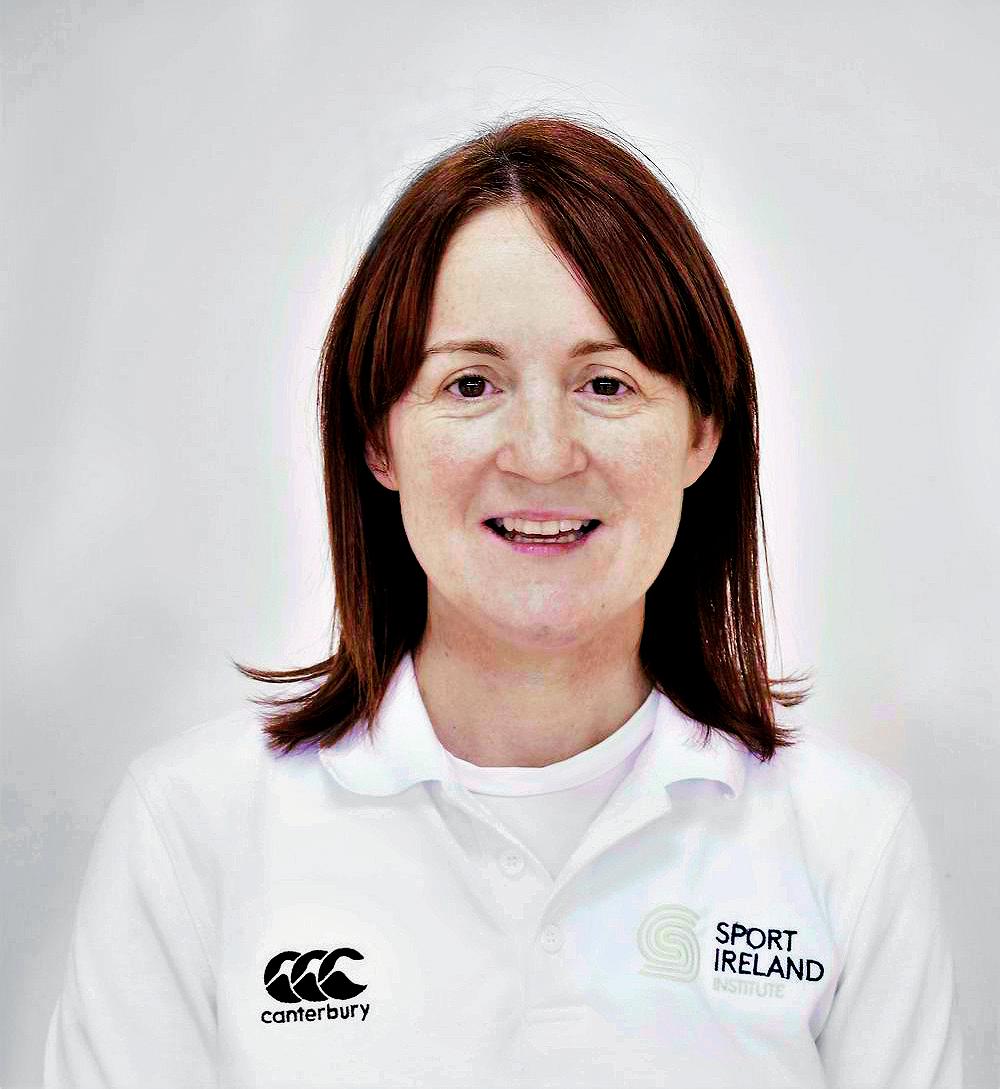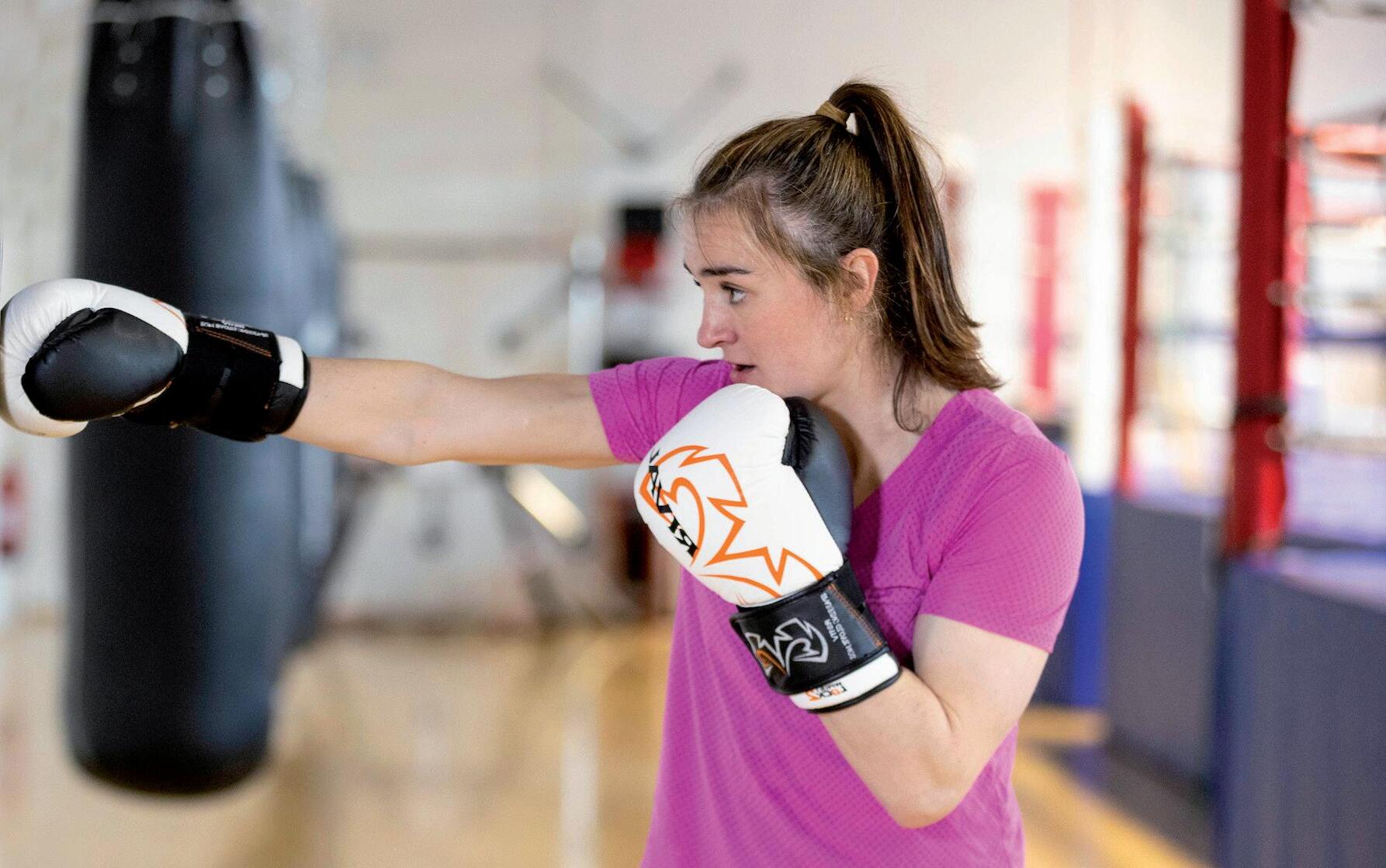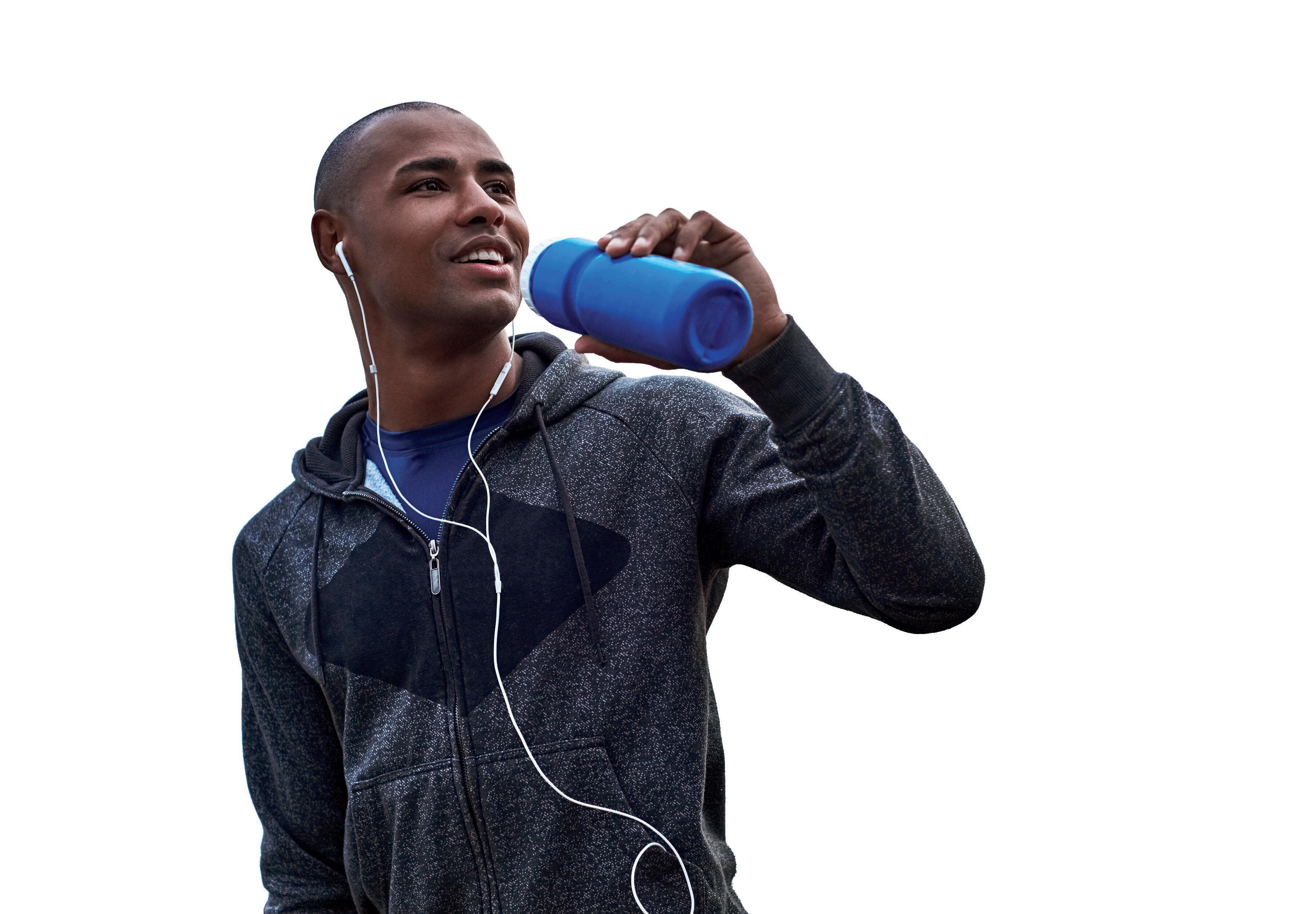SPORTS NUTRITION HANDBOOK
FUELLING WISE FOR SPORT & EXERCISE

ndc.ie
Dr Sharon Madigan Head of Performance Nutrition, Sport Ireland Institute

“Paying attention to eating and drinking habits can impact greatly on the performance of all athletes at all levels. Food is an effective performance enhancer in many ways. It provides us with energy, it builds and rebuilds the body and it can deliver nutrients that are the building blocks of many of the physiological processes involved in exercise. Training plans rarely stay static, so neither should your nutrition routine. All athletes will benefit if they tailor their food intakes to suit their own individual needs and are aware that these needs can change throughout the training and competition seasons.”
Professor Niall Moyna Head

of the School of Health and Human Performance, Dublin City University
“The benefits of regular physical activity are indisputable. Regular physical activity is a key element of a healthy lifestyle and is known to prevent disease, enhance wellbeing and increase lifespan. Indeed, if the known benefits of physical activity could be packaged into a pill, it would be the most prescribed wonderdrug on the planet! Any form of physical activity is better than none. Even short 10 to 15 minute bouts of low-intensity physical activity such as walking or housework have substantial health benefits. Ideally, adults should accumulate 30 minutes of physical activity every day; whereas young people should aim for a minimum of 60 minutes of physical activity per day.”


Contents Performance Nutrition – do the basics matter? 1 Body Composition - what’s your goal? 3 Carbohydrate – friend or foe? 5 Protein – why, when and how much? 7 Fat – do I need it? 9 Hydration – how important is it? 10 Milk – nature’s recovery drink? 11 What should I consider? – before, during and after sport 13 Supplements – worth the hype? 14 Further Reading 14 Elite Eats – Recipes 15
Performance Nutrition:
do the basics matter?
Whether an elite athlete, involved in a local sports club or a dedicated gym bunny; a healthy, balanced diet is essential for meeting energy and nutrient demands.

Kellie Harrington
A variety of factors influence our individual nutritional needs such as gender, age and body size. The type, amount and timing of food will also depend on the competitive level you are involved in and the specific demands of your training schedule.
The first step for optimum performance nutrition is to ensure that nutrient needs are met by including a variety of nutritious foods across meals and snacks. The Department of Health’s Food Pyramid is a useful tool to guide balanced, healthy eating choices (see www.healthyireland.ie). The second step is to focus on the timing of food and fluid intakes around training sessions, matches and competitions (see page 13).
World Champion Boxer & Olympic Gold Medallist
“Being an athlete, it is really important that I fuel my body properly so that I can perform at my best during training sessions and competitions. A lot of my achievements are down to hard work, eating the right food and getting plenty of rest. You have to start by making small changes. These small changes add up and, before you know it, these changes become permanent healthy habits.”
Sports Nutrition Handbook 1
Clever Choices
• Include complex carbohydrate foods (e.g. wholemeal varieties of cereal, bread, rice, pasta, noodles) in meals and snacks to help ensure energy stores are well-fuelled.
• Include protein foods (e.g. milk, lean meat, eggs, beans, lentils, yogurt, cheese, fish) at each mealtime to ensure hard-working muscles have a constant supply of protein throughout the day.
• Include a wide variety of fruits and vegetables across meals and snacks for a good range of vitamins and minerals.
• Avoid too many processed foods that are high in fat, sugar or salt e.g. biscuits, cakes, crisps.
• Avoid or limit alcohol as it can dehydrate the body and impair recovery.
• Get cooking! Preparing and cooking your own meals will give you control over what you eat and is a great life-long skill. Batch cooking healthy meals for the freezer can help you stick to your healthy eating plan on busy days.
• If playing sport at a frequent or intense level, consider seeking advice from a sports nutritionist/dietitian who can tailor food and fluid advice to your specific needs and goals.

Fuelling Wise for Sport & Exercise 2
Body Composition: what’s your goal?
Our diet and training habits can greatly influence the amounts of fat and muscle in our bodies. These amounts are particularly important for those involved in sport, as body composition can affect our performance.
When we consume more energy (calories) than we use, this can result in weight gain over time. Similarly, if we use up more energy than we consume, this will result in weight loss. Our food provides calories, with the macronutrients (‘macros’) carbohydrate, protein and fat containing various amounts of calories (kcals). Per gram, carbohydrate provides 4 kcals; protein 4 kcals; and fat 9 kcals.
Our goal for body composition will depend on the type of sport we are involved in. For example, those who are light with a lower percentage of body fat typically have an advantage in endurance sports such as longdistance running. Heavier individuals with a high muscle mass can have an advantage for resistance against opponents; or for providing strength for throwing and sprinting.
Males Females Athletes 6-13 % 14-20 % Fitness 14-17 % 21-24 % Average 18-24 % 25-31 % Obesity ≥ 25 % ≥ 32 %
General ranges for percentage body fat: Sports Nutrition Handbook 3
Source: American Council on Exercise
Losing Weight: Tips
• Body fat has important roles and dropping too low can have negative health effects. Remember that females require a higher fat percentage than men.
• Losing weight too quickly is unhealthy and can result in a loss of muscle as well as fat, which is undesirable. Be patient and aim for an achievable 0.5-1 kg loss per week.
• Beware of fad diets as these are generally extreme and difficult to stick to. Avoid skipping meals and follow a balanced diet to ensure nutrient needs are met (see tips on page 2).
• Being organised and planning ahead are key. Bring healthy snacks to school, work or when travelling (e.g. fruit, yogurt, plain nuts) to avoid unhealthier impulse decisions when hungry.
Gaining Muscle: Tips
• Aim for increases of 0.3-0.5 kg per week; and combine with a training programme to ensure body weight gains are muscle rather than fat.
• Increase calorie intake by choosing healthy and nutritious foods. For example, although fat provides more calories per gram, avoid overindulgence in high fat, processed foods as this may result in fat gain rather than muscle gain.
• Protein plays an important role in muscle growth and maintenance. Generally, 1.2-2 g of protein per kilogram of body weight ensures needs are met for gaining muscle (see pages 7-8).
• Be aware that alcohol also provides calories (1 g= 7 kcals). As examples, a pint of beer contains about 210 kcals; while a small glass of wine provides about 85 kcals.
• Increase meal frequency to 4-5 times per day. This helps to avoid stomach discomfort that may result from eating a high volume of food across three meals.
• Try not to compare your results to others as the ability to gain muscle is determined by our individual genetic ability. Be patient and avoid unnecessary ‘quick fixes’. If considering the use of muscle-gaining supplements, discuss their safety and effectiveness with a sports dietitian.

Fuelling Wise for Sport & Exercise 4
Carbohydrate: friend or foe?
Carbohydrates have received some unwarranted negative publicity in recent years, with trends towards ‘low-carb’ and ‘no-carb’ diets gaining popularity.
In fact, carbohydrates are essential energy providers and are particularly useful for active sports people. Carbohydrate energy is stored as ‘glycogen’ and blood glucose in the body. These stores can be used up quickly and cause fatigue – affecting both performance and stamina. Carbohydrate requirements will depend on a number of factors such as the amount, intensity and duration of training, as well as body size and non-sport activities.

Average daily carbohydrate requirements for moderate to intense exercise (grams per kilogram of body weight):
Source: Bean A. Sports Nutrition (4th Edition)
Hours of Activity Carbohydrate Intake (g per kg) 3-5 hours/week 4-5 5-7 hours/week 5-6 1-2 hours/day 6-7 2-4 hours/day 7-8 >4 hours/day 8-10
Sports Nutrition Handbook 5
Food servings providing approximately 50 g of carbohydrate:
Source: McCance and Widdowson’s The Composition of Foods (7th Summary Edition)
Glycemic Index (GI)
Carbohydrate foods can be divided into ratings of between 0-100 based on how fast they cause our blood sugar to rise after eating. This rating is referred to as their ‘glycemic index’.
Low GI foods (e.g. porridge, yogurt, apples, nuts) give a more gradual rise in blood sugar levels; with high GI foods (e.g. white bread, cereal bars, jellies) rapidly increasing levels. Low GI foods generally contain less sugar, more fibre and nutrients; and are therefore important components of a healthy diet.
High GI foods generally contain higher levels of added sugar and are not usually part of a healthy eating plan. However, these foods can be useful in certain situations such as for quick energy release before exercise or where rapid refuelling is needed after exercise.

Lactose - not the same as other sugar
Milk contains the naturally occurring sugar lactose (approximately 5 g per 100 ml), as indicated on nutritional information labelling. Nutritionally, lactose is not classified in the same category as ‘free’ or ‘added’ sugars. Generally, sugar is not added to milk unless specified in the ingredients list e.g. in flavoured milks.
The World Health Organisation (WHO) have focused on restricting ‘added’ or ‘free’ sugars plus sugars naturally present in honey, syrups and unsweetened fruit juices. It is important to remember that lactose does not fall into this category of ‘added’ or ‘free’ sugars, even though it is still declared as ‘sugar’ on nutrition labels.
Food Serving Size Porridge oats 70 g Wholemeal bread 120 g Fruit scone 90 g Rice, wholegrain 170 g Pasta 150 g Baked potato 220 g Fresh fruit salad 350 g Honey 4 tbsp Cereal bar 80 g Chocolate milk 430 ml Sports drink 160 ml
Fuelling Wise for Sport & Exercise 6
Protein: why, when and how much?
As well as relying on our muscles for support and movement in everyday tasks, those involved in sport and exercise need strong, healthy muscles to withstand training and performance demands.

Along with a balanced diet that provides enough energy, protein is an essential nutrient that contributes to the normal growth and maintenance of muscles.
Timing and quality are important when it comes to protein and the optimal approach is to spread intakes across the day rather than consuming a large amount at one meal. This enables the body to supply a constant amount needed by active muscles throughout the day. Consuming protein (approximately 20-25 g) following an intense session is particularly useful to assist muscle growth and repair.
Protein requirements are estimated based on individual body weight; with slight variations depending on the type and intensity of activity.
General ranges for daily protein requirements per
kilogram of body weight:
Source: Position of the Academy of Nutrition and Dietetics, Dietitians of Canada, and the American College of Sports Medicine; and the European Food Safety Authority
Group Protein intake (g/kg/day) Inactive men and women 0.8-1.0 Strength power and resistance 1.2-2.0
Sports Nutrition Handbook 7
Foods such as lean meat, fish, eggs, milk, cheese and yogurt are among the best protein providers as these are ‘complete’ protein sources – providing all of the amino acids (building blocks of protein) that the body needs. Other protein sources include beans, lentils, nuts and seeds.
Protein content of foods:
Source: McCance and Widdowson’s The Composition of Foods (7th Summary Edition)
Fuelling Wise for Sport & Exercise 8
Food Portion Size Protein (grams) Chicken breast, grilled 100g - medium size 32 Beef steak 100g 34 Cod/salmon 100g 24 Tuna, canned 120g 30 Boiled eggs 2 eggs – average size 14 Cheddar cheese 25 g 6 Milk (whole/low-fat) 200 ml 7 Yogurt plain, low-fat 125 g 6 Yogurt, Greek-style 125 g 7 Cottage cheese 75 g 7 Baked beans 150 g 8 Pumpkin seeds 40 g 10 Mixed nuts 40 g 10 Chickpeas 150 g 11
Fat: do I need it?
Fat is essential for our health, with a number of important roles including brain function, cell structure and the absorption of certain vitamins. However, including the right type and amount of fat in the diet is important.
• As fats and oils are high in calories try to use these sparingly. When cooking with oil choose oils such as olive, sunflower or rapeseed.
Fat Fact
While carbohydrates are used as the main energy source for high intensity exercise, during low intensity and prolonged exercise fat stores can play an important role in providing energy. With training, the body’s ability to use fat as fuel improves. This can be beneficial as carbohydrate stores (glycogen) are in much shorter supply than fat stores – allowing us to spare glycogen and delay fatigue.

Sports Nutrition Handbook 9
Hydration: how important is it?

Sweating is a natural reaction during exercise to prevent the body overheating, but it does
Being even slightly dehydrated (as little as 2 % body weight lost as sweat) can negatively impact aspects of performance such as decision-making, concentration and reaction
Fuelling Wise for Sport & Exercise 10
Milk: nature’s recovery drink?
Milk is often referred to as an excellent choice after exercise. This is because research is expanding on the specific benefits of milk in sport, with potential roles in the areas of recovery nutrition being explored.
Milk naturally contains nutrients that can help address the 3 ‘R’s of post-exercise recovery:

1) REFUEL: Milk contains lactose which can help to start the refuelling of carbohydrate stores. Flavoured milks – which contain higher carbohydrate amounts in the form of added sugar – may be useful after a very intense session, or when quick recovery is needed.
2) REPAIR: Milk provides the high-quality proteins, whey and casein. Protein plays a valuable role in the normal growth and maintenance of muscles.
3) REHYDRATE: Milk is a fluid (naturally composed of about 88 % water) and naturally contains electrolytes such as potassium. As well as being an affordable, natural, versatile and widely available choice after exercise, milk provides a range of vitamins and minerals which have roles in health that are particularly useful for those who are active. For example, milk provides calcium, protein and phosphorus to support bone health; vitamin B2 to assist with energy release; iodine to contribute to normal cognitive (brain) function; and vitamin B12 to support normal functioning of the immune system
Did you know?
The Department of Health’s guidelines for healthy eating recommend 3 servings from the ‘milk, yogurt and cheese’ food group; with 5 servings recommended for those aged 9-18 years. Examples of a single serving include: 200 ml of milk; 125 g of yogurt; or 25 g of cheddar cheese.
Sports Nutrition Handbook 11
Fluid and Electrolytes
Carbohydrate (Lactose)
Calcium
Phosphorus


Potassium
THE 3 ‘R’S OF POST-EXERCISE RECOVERY
Casein)
Vitamin B12
NATURALSOURCE OF VITAMINS ANDMINERALS
• Convenient
• Affordable
• Versatile
• Accessible
Did you know?
Ireland is among the best places in the world for sustainable milk production.

• Irish dairy farms have one of the lowest carbon footprints in the world.
• Our mild, wet climate makes grassland one of the most successful crops in Ireland.
• Cows convert grass into affordable nutritious dairy foods, which make a valuable contribution to healthy, sustainable diets.
• Ireland’s agri-food industry and its farmers are proactively working together with a commitment to improving biodiversity and lowering the carbon footprint of Irish dairy. For more information, visit www.ndc.ie
tura Min
EHYDRATE
R
Vitamin B2 Iodine R EPAIR Protein (Whey &
R EFUEL
Fuelling Wise for Sport & Exercise 12
What should I consider?… before, during and after sport
Before – fuel up
Meals or snacks consumed before sport should be carbohydrate-based (e.g. wholemeal bread, pasta, rice, cereals, potatoes) and ensure enough time for digestion to avoid feelings of discomfort during exercise.
• Consuming a carbohydrate-rich meal which contains some protein is often advised 3-4 hours before a sports session. Examples include: a rice/pasta meal with a tomato-based sauce and lean meat; baked sweet potato with beans/tuna and grated cheddar; eggs (e.g. poached, boiled or scrambled) on toast; soup with a cheese/ egg/meat sandwich.
• If eating 1-2 hours beforehand, the above ideas can be reduced in portion size or opt for: a fruit-vegetable smoothie; breakfast cereal with milk; slice of toast with jam/ peanut butter.
• If your session is early in the morning or you need a pre-performance snack 3060 minutes beforehand, ideas include: a banana; a yogurt; some fruit juice; or a small serving of overnight oats.
During – keep hydrated
There is generally no need for an energy top-up during a session that lasts less than 60 minutes, but continue to hydrate with water at breaks of activity e.g. 150-200 ml every 15-20 minutes. Carbohydrate intake may be useful during intense exercise lasting longer than 60 minutes: mandarins/orange segments, jellies, sports drinks/gels may be practical options.
After - recovery
Effective recovery from an intense exercise session is essential to perform at your best in the next training session, match or competition.
• After exercise, there are three main priorities to consider, often referred to as the 3 ‘R’s of recovery: Refuel energy stores; Repair muscles; and Rehydrate.
• Carbohydrate and protein are the main nutrients to consider: carbohydrate assists with the refuelling of energy stores, while protein plays an important role in muscle growth and repair.
• As the body replenishes carbohydrate stores (glycogen) at a faster rate immediately after exercise, aim to eat carbohydrate-based foods with some protein within 30-60 minutes after exercise to begin refuelling energy stores and assisting muscle repair. Follow up with a substantial meal based on carbohydrate foods such as bread, pasta, rice or potatoes; paired with lean protein sources such as meat, fish or poultry; and include a variety of vegetables to contribute to vitamin and mineral intakes.
Recovery Meal & Snack Ideas
• 2 boiled eggs; 2 slices wholemeal toast; ½ an avocado
• Smoothie: 150 mls Greek-style yogurt; 250 mls of milk; 140 g mixed berries
For more recipe ideas, see pages 15-16.
Sports Nutrition Handbook 13
Supplements: worth the hype?
Supplements include a wide range of pills, powders, bars, drinks and gels and can be classed as nutrients, functional foods, sports foods and ergogenic aids.
It is important to remember that supplements do not offer a shortcut to good performance: talent, training, good nutrition and adequate rest are all essential. Generally, if following a balanced, varied diet and unless a nutrient deficiency is identified, there is no need to take any nutritional supplements. Athletes may find some food supplements such as protein powders or sports drinks convenient on occasions where food sources are not readily available or if quick recovery is required between sessions.
If training at a competitive or intense level, a sports dietitian can offer advice on supplement use depending on individual needs. Before using any supplement, athletes should consider if they are shown to be effective, safe and legal. For more information, please visit www.sportireland.ie.
For those under the age of 18 years, supplements are not advised and all nutrient needs should be met from dietary intakes.
Further Reading: Sport & Exercise Nutrition

• The National Dairy Council - www.ndc.ie
• Sport Ireland - www.sportireland.ie
• Department of Health - (2016) The Healthy Eating Guidelines and Food Pyramid www.healthyireland.ie
• Irish Nutrition and Dietetic InstituteFactsheets www.indi.ie/fact-sheets
• safefood - www.safefood.net
Fuelling Wise for Sport & Exercise 14
Elite Eats: Recipes
The following recipes have been created by Performance Nutritionists with the Sport Ireland Institute, who oversee the dietary needs of Ireland’s elite athletes and Olympians across a wide range of sports.
Berry Smoothie (SERVES 1)

INGREDIENTS
140 g mixed berries (frozen)
250 ml semiskimmed milk
1 small banana
125 g low-fat Greek-style yogurt
3 teaspoons of honey
Nutritional Composition: Per/ Serving
Energy 375 kcal
Carbohydrate 57 g
Protein 24 g
Fat 5 g
METHOD
• Simply add all ingredients into a blender, mix, and pour.
• Optional extra: Add ice cubes.
WHEN TO HAVE
Ideal as a post-training recovery drink, or an on-the-go early breakfast.
OPTIONS TO INCREASE CALORIES
• Use whole milk instead of skimmed
• Use regular Greek-style yogurt instead of low-fat
• Add 1 dessertspoon of peanut butter
• Add 2 dessertspoons of oats
Sports Nutrition Handbook 15
Yogurt Bowl (SERVES 1)
INGREDIENTS
225 g of 0% Greek-style yogurt
3 large squares of 80-90% dark chocolate
1 tablespoon of honey
1 tablespoon of peanut butter (smooth)
2 tablespoons of dried fruit
Nutritional Composition: Per/ Serving
Energy 531 kcal
Carbohydrate 53 g
Protein 31 g
Fat 21 g
METHOD
• Add yogurt, dried fruit and peanut butter to a bowl.
• Break up/grate the dark chocolate and add. Drizzle with honey.
WHEN TO HAVE
Ideal as a pre-training breakfast or post-training recovery snack.
OPTIONS TO INCREASE CALORIES
• Use regular Greek-style yogurt instead of low-fat

• Add an extra tablespoon of peanut butter
• Add a banana
• Add granola
Overnight Oats (SERVES 1)

INGREDIENTS
60 g oat flakes
60 g mixed berries (frozen)
250 mls
whole milk
50 g natural yogurt
1 teaspoon of cinnamon
1 tablespoon of honey
Nutritional Composition: Per/ Serving
Energy 554 kcal
Carbohydrate 73 g
Protein 19 g
Fat 19 g
METHOD
• Add oats, milk, cinnamon and yogurt to a jar the night before and stir well. Add the berries and place in fridge overnight.
• The next morning stir well, add a little more milk if needed, and add honey.
WHEN TO HAVE
Perfect for breakfast or pre- or posttraining snack.
OPTIONS TO INCREASE CALORIES
• Add a tablespoon of peanut butter
• Add mixed seeds
• Add granola
• Add extra oats
Fuelling Wise for Sport & Exercise 16

2021 This booklet is fully recyclable t: +353 1 290 2451 e: publications@ndc.ie w: ndc.ie NDCIreland NDC_ie @NDC_ie

















